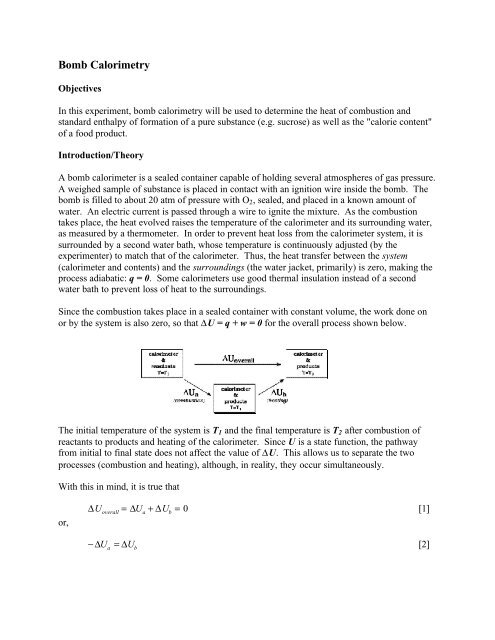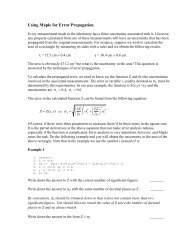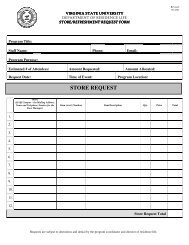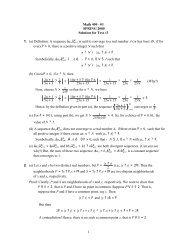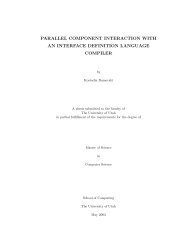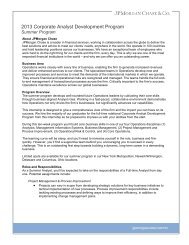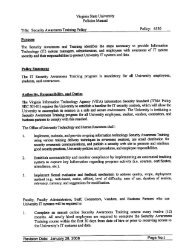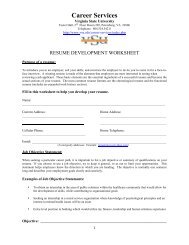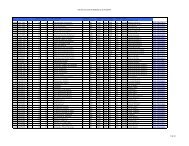Bomb Calorimetry
Bomb Calorimetry
Bomb Calorimetry
Create successful ePaper yourself
Turn your PDF publications into a flip-book with our unique Google optimized e-Paper software.
<strong>Bomb</strong> <strong>Calorimetry</strong>ObjectivesIn this experiment, bomb calorimetry will be used to determine the heat of combustion andstandard enthalpy of formation of a pure substance (e.g. sucrose) as well as the "calorie content"of a food product.Introduction/TheoryA bomb calorimeter is a sealed container capable of holding several atmospheres of gas pressure.A weighed sample of substance is placed in contact with an ignition wire inside the bomb. Thebomb is filled to about 20 atm of pressure with O 2 , sealed, and placed in a known amount ofwater. An electric current is passed through a wire to ignite the mixture. As the combustiontakes place, the heat evolved raises the temperature of the calorimeter and its surrounding water,as measured by a thermometer. In order to prevent heat loss from the calorimeter system, it issurrounded by a second water bath, whose temperature is continuously adjusted (by theexperimenter) to match that of the calorimeter. Thus, the heat transfer between the system(calorimeter and contents) and the surroundings (the water jacket, primarily) is zero, making theprocess adiabatic: q = 0. Some calorimeters use good thermal insulation instead of a secondwater bath to prevent loss of heat to the surroundings.Since the combustion takes place in a sealed container with constant volume, the work done onor by the system is also zero, so that DU = q + w = 0 for the overall process shown below.The initial temperature of the system is T 1 and the final temperature is T 2 after combustion ofreactants to products and heating of the calorimeter. Since U is a state function, the pathwayfrom initial to final state does not affect the value of DU. This allows us to separate the twoprocesses (combustion and heating), although, in reality, they occur simultaneously.With this in mind, it is true thator,∆U overall= ∆U a+ ∆U b= 0 [1]− ∆U a= ∆U b[2]
But, since Step b simply involves heating up the calorimeter and contents from T 1 to T 2 ,∆U b= C V∆T = C V( T 2− T 1) [3]Note that C V is the heat capacity of the bomb calorimeter and its contents. From equations [2]and [3], the change in internal energy of combustion can be readily found from the change ininternal energy of heating.The molar enthalpy of combustion DH m is given by the equation:∆H comb,m= ∆U comb,m+ RT comb∆n gas[4]where T comb is the temperature at which combustion occurs, Dn gas is the change in the number ofmoles of gas (in the balanced reaction representing the combustion of one mole of compound).To ensure that units match, Dn gas should be treated as unitless.Determining the heat evolved during the combustion from Equation 3 requires knowledge of theheat capacity of the calorimeter often called the calorimeter constant. By combusting a samplewith a known molar heat of combustion, we can use the measured temperature change andEquation 3 to calculate the calorimeter constant.Procedure1. Turn on the water and the hot water heater.2. Form and accurately weigh three pellets of special grade benzoic acid not exceeding1 gram.If any pellet exceeds this limit, it must be shaved off to a 1 gram maximum.3. Place one of the pellets in the stainless steel cup and attach ~10 cm of ignition wire to theelectrodes tightly with a loop of wire just touching the top of the pellet. Make sure that theignition wire does not touch metal or it will short and the sample will not ignite.4. When closing bomb, tighten down the cap by HAND only. Close the outlet valve. Attachthe union from the oxygen tank, turning it down lightly by hand. Close the filling valvebetween the bomb and gauge (turn clockwise). Open the main tank valve 1/4 turn, open thefilling valve slowly and allow the pressure to build up slowly to 25 atm. Purge the bombwith pure oxygen twice. Then close the filling valve and the tank valve and open the reliefvalve under the gauge. The excess pressure in the bomb closes the inlet valve. Unscrew theunion.5. Attach the electrode wires to the contacts in the bomb head.2
6. Place 2000 mL of water measured from a volumetric flask at 25°C in the stainless steelwater bucket. Be sure the ignition wires are towards the front of the bucket, away from thestirrer. Close the lid and turn on the stirrer.7. Adjust jacket temperature to within 0.03°C of calorimeter temperature by running hot orcold water into the jacket. The pilot light on the water heater should be off before beginninga run.8. Take temperature readings every 30 seconds for two minutes BEFORE igniting the bomb.9. Ignite the sample by pressing the firing button for 5 seconds AND NO LONGER! (Theindicator light may be burned out.)10. After a delay of 10 or 15 seconds, the temperature should begin to rise in the inner bucket.Keep the jacket and bucket temperature to within 0.03°C by running hot water slowly intothe jacket. Read the temperature of the calorimeter every minute for 5 to 8 minutes afterigniting the bomb.11. Once the temperature reaches a plateau, remove the bomb and release the pressure. Openthe bomb and recover any fuse wire remaining. Weigh or measure the length of theremaining fuse wire.12. Combust at least three samples of the benzoic acid standard and at least one sucrose and onefood product sample (with a clearly labeled caloric content!).3
CalculationsFor each combustion, determine DT.During ignition, part of the ignition wire combusts, thereby adding heat to the system. The extraheat must therefore be subtracted from the total. The amount of heat liberated per gram and percm of fuse wire is listed on the spool.∆U a= −C V∆T + q wire[5]Heat Capacity of the CalorimeterThe balanced equation for the combustion of one mole of benzoic acid [122.1 g mol -1 ] is:C 6 H 5 CO 2 H(s) + 152 O 2 (g) à 7 CO 2 (g) + 3H 2 O(l)The standard molar enthalpy of combustion for benzoic acid is DH comb,m = – 3227 kJ mol -1 . Thestandard molar energy of combustion for benzoic acid can thus be calculated.o∆U comb,mo= ∆H comb,m− RT∆n gas= −3227 kJ mol –1 − 8.314E − 3 kJ mol –1 K –1= −3227 kJ mol –1 + 1.24 kJ mol –1( ) 298K( )( 7 −15 2)= −3226 kJ mol –1Using DU comb,m the heat capacity for the calorimeter, C cal can be calculated using equation 5.Molar Enthalpy of Combustion for SucroseWrite the chemical reaction for the complete combustion of one mole of sucrose. Calculate DU°for the combustion of your sample fromo∆U comb= −C cal( T 2− T 1)+ q wire[6]Determine the molar change in internal energy in kJ mol –1 . Then calculate the molar enthalpy ofcombustion from equation [4] using T=298K ~ T 1 .Compare your value with that listed in the literature.Now calculate the standard enthalpy of formation of sucrose from your enthalpy of combustionand the enthalpies of formation of CO 2 and H 2 O.4
Molar Enthalpy of Combustion for Food ProductSince these substances are not pure, one can only calculate the heat of combustion per gram,assuming that DU ~ DH. Find DH (in kJ/gram) for each substance tested. Compare to the stated"calorie content" on the product label.Questions1. What are the two major assumptions implicit in the use of Equation [4] in this experiment?2. When 2.25 mg of anthracene, C 14 H 10 (s), was burned in a bomb calorimeter the temperaturerose by 1.05K. Calculate the calorimeter constant. By how much will the temperature risewhen 5 mg of phenol, C 6 H 5 OH(s), is burned in the calorimeter under the same conditions?3. Using the same calorimeter, by how much will the temperature rise when 5 mg of aniline,C 6 H 5 NH 2 (l) is combusted?5


